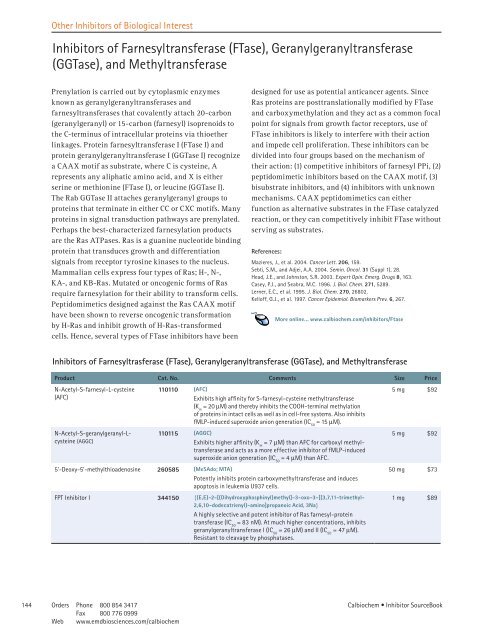Inhibitor SourceBook™ Second Edition
Inhibitor SourceBook™ Second Edition
Inhibitor SourceBook™ Second Edition
You also want an ePaper? Increase the reach of your titles
YUMPU automatically turns print PDFs into web optimized ePapers that Google loves.
Other <strong>Inhibitor</strong>s of Biological Interest<br />
<strong>Inhibitor</strong>s of Farnesyltransferase (FTase), Geranylgeranyltransferase<br />
(GGTase), and Methyltransferase<br />
Prenylation is carried out by cytoplasmic enzymes<br />
known as geranylgeranyltransferases and<br />
farnesyltransferases that covalently attach 20-carbon<br />
(geranylgeranyl) or 15-carbon (farnesyl) isoprenoids to<br />
the C-terminus of intracellular proteins via thioether<br />
linkages. Protein farnesyltransferase I (FTase I) and<br />
protein geranylgeranyltransferase I (GGTase I) recognize<br />
a CAAX motif as substrate, where C is cysteine, A<br />
represents any aliphatic amino acid, and X is either<br />
serine or methionine (FTase I), or leucine (GGTase I).<br />
The Rab GGTase II attaches geranylgeranyl groups to<br />
proteins that terminate in either CC or CXC motifs. Many<br />
proteins in signal transduction pathways are prenylated.<br />
Perhaps the best-characterized farnesylation products<br />
are the Ras ATPases. Ras is a guanine nucleotide binding<br />
protein that transduces growth and differentiation<br />
signals from receptor tyrosine kinases to the nucleus.<br />
Mammalian cells express four types of Ras; H-, N-,<br />
KA-, and KB-Ras. Mutated or oncogenic forms of Ras<br />
require farnesylation for their ability to transform cells.<br />
Peptidomimetics designed against the Ras CAAX motif<br />
have been shown to reverse oncogenic transformation<br />
by H-Ras and inhibit growth of H-Ras-transformed<br />
cells. Hence, several types of FTase inhibitors have been<br />
designed for use as potential anticancer agents. Since<br />
Ras proteins are posttranslationally modified by FTase<br />
and carboxymethylation and they act as a common focal<br />
point for signals from growth factor receptors, use of<br />
FTase inhibitors is likely to interfere with their action<br />
and impede cell proliferation. These inhibitors can be<br />
divided into four groups based on the mechanism of<br />
their action: (1) competitive inhibitors of farnesyl PPi, (2)<br />
peptidomimetic inhibitors based on the CAAX motif, (3)<br />
bisubstrate inhibitors, and (4) inhibitors with unknown<br />
mechanisms. CAAX peptidomimetics can either<br />
function as alternative substrates in the FTase catalyzed<br />
reaction, or they can competitively inhibit FTase without<br />
serving as substrates.<br />
References:<br />
Mazieres, J., et al. 2004. Cancer Lett. 206, 59.<br />
Sebti, S.M., and Adjei, A.A. 2004. Semin. Oncol. 31 (Suppl ), 28.<br />
Head, J.E., and Johnston, S.R. 2003. Expert Opin. Emerg. Drugs 8, 63.<br />
Casey, P.J., and Seabra, M.C. 996. J. Biol. Chem. 271, 5289.<br />
Lerner, E.C., et al. 995. J. Biol. Chem. 270, 26802.<br />
Kelloff, G.J., et al. 997. Cancer Epidemiol. Biomarkers Prev. 6, 267.<br />
Product Cat. No. Comments Size Price<br />
N-Acetyl-S-farnesyl-L-cysteine<br />
(AFC)<br />
N-Acetyl-S-geranylgeranyl-Lcysteine<br />
(AGGC)<br />
More online... www.calbiochem.com/inhibitors/Ftase<br />
<strong>Inhibitor</strong>s of Farnesyltrasferase (FTase), Geranylgeranyltransferase (GGTase), and Methyltransferase<br />
110110 (AFC)<br />
Exhibits high affinity for S-farnesyl-cysteine methyltransferase<br />
(K m = 20 mM) and thereby inhibits the COOH-terminal methylation<br />
of proteins in intact cells as well as in cell-free systems. Also inhibits<br />
fMLP-induced superoxide anion generation (IC 50 = 5 mM).<br />
110115 (AGGC)<br />
Exhibits higher affinity (K m = 7 mM) than AFC for carboxyl methyltransferase<br />
and acts as a more effective inhibitor of fMLP-induced<br />
superoxide anion generation (IC 50 = 4 mM) than AFC.<br />
5'-Deoxy-5'-methylthioadenosine 260585 (MeSAdo; MTA)<br />
Potently inhibits protein carboxymethyltransferase and induces<br />
apoptosis in leukemia U937 cells.<br />
FPT <strong>Inhibitor</strong> I 344150 {(E,E)-2-[(Dihydroxyphosphinyl)methyl]-3-oxo-3-[(3,7,11-trimethyl-<br />
2,6,10-dodecatrienyl)-amino]propanoic Acid, 3Na}<br />
A highly selective and potent inhibitor of Ras farnesyl-protein<br />
transferase (IC 50 = 83 nM). At much higher concentrations, inhibits<br />
geranylgeranyltransferase I (IC 50 = 26 mM) and II (IC 50 = 47 mM).<br />
Resistant to cleavage by phosphatases.<br />
5 mg $92<br />
5 mg $92<br />
50 mg $73<br />
mg $89<br />
44 Orders Phone 800 854 34 7<br />
Calbiochem • <strong>Inhibitor</strong> SourceBook<br />
Fax 800 776 0999<br />
Web www.emdbiosciences.com/calbiochem



